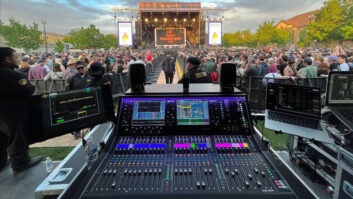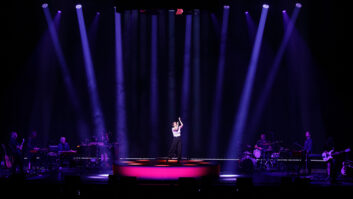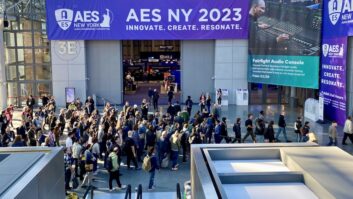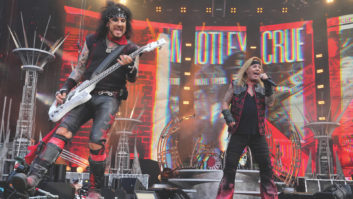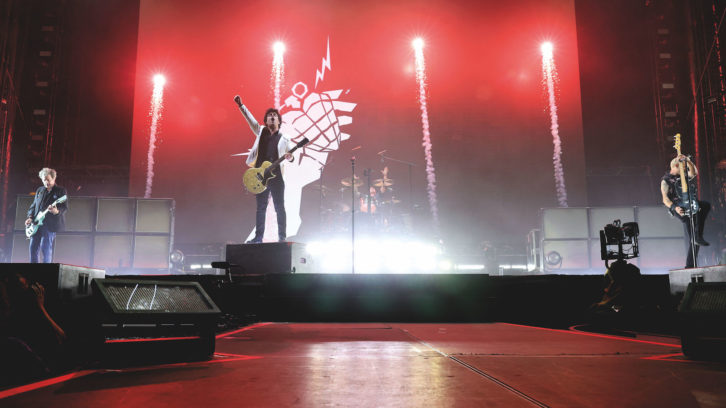
This summer’s Hella Mega Tour came after a Hella Mega Long Wait. Bringing together a three-pronged rock attack of Green Day, Fall Out Boy and Weezer, the massive world stadium tour was first announced back in September, 2019, with all three bands releasing singles, that teased new albums, that primed the tour…that didn’t happen. After months of rehearsals, rig building and the rest, Hella Mega found itself all dressed up with nowhere to go after COVID-19 brought the concert industry to a standstill in March, 2020, only a week before the first tour leg though Asia was due to begin. As the months wore on, leg after leg got postponed, and an Oceania run was simply cancelled, but with vaccinations on the rise and COVID briefly on the ropes as Summer 2021 began, it was time to get the show on the road.
Hella Mega finally kicked off July 24 at Globe Life Field in Arlington, TX and never looked back, spending the next six weeks careening around the U.S. before wrapping up in Seattle in early September. Across 29 shows, the tour played 35,000- 40,000 seat stadiums that were usually sold out with crowds ready to let off a little—OK, a lot of steam after 18 months of COVID-induced uncertainty. The tour was up to the challenge, however, with the bands rolling through hit-heavy setlists while the audio team ensured that audiences left every show thoroughly rocked.
“It’s been a long time coming,” said crew chief and system engineer Clark Thomas, speaking under the FOH tent on a broiling August afternoon at HersheyPark Stadium in Hershey, Pennsylvania. “We had to re-prep all this gear that’s been sitting around forever and blow the dust off it, so to speak.” The tour carried a d&b audiotechnik GSL line array system provided by Eighth Day Sound (which also provided gear for Green Day, while Clair Global handled Fall Out Boy). As it turned out, pro audio gear isn’t designed to spend two years offline, but getting it back in fighting shape wasn’t that difficult either. “The routine pretty much stays the same,” said Thomas. “You go through, check all your cabling, drivers, cabinets and make sure everything’s happy and talking the way it should. Maybe you find some cabling that mysteriously went bad getting oxidation. Here and there, the little audio Gremlins came in and definitely had their way, but it’s gone well since we’ve been out here.”

A typical day’s hang sported 24 GSL line array modules per side on the main hangs, while the side hangs were comprised of 20 J-Series boxes per side; all of that was supported by 30 SL-SUB subwoofers across the front of the stage. “We like the intelligibility,” said Thomas. “You don’t really need flown subs with GSL, because there’s a lot of low end coming off the main arrays as-is. We stayed away from flying subs because everything we need is there; there’s no sense in adding multiple sources just for the sake of doing it. Coverage left to right is amazing, and it has great processing to get up into the backs of venues. You can definitely tell the difference from your conventional line arrays with two box circuits—there’s a lot of control there. And, of course, d&b has always been easy to use, as per usual.”
Sending audio down the line to all those speakers was an XTA MX36 console switching system, allowing the production to quickly change between the four desks on hand—Fall Out Boy was mixed on a DiGiCo SD5; Weezer had a DiGiCo SD12; openers The Interrupters were mixed on the emergency backup desk, an Avid S6L-24C; and Green Day? Well, that was something else entirely: a Rupert Neve Designs 5088 analog mixing desk.
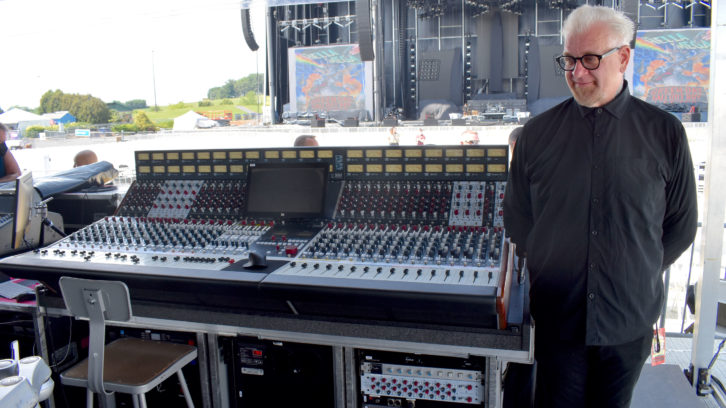
BRINGING THE STUDIO ON THE ROAD
“There’s never been one on the road before,” beamed Kevin Lemoine, the band’s house engineer for the last 21 years. “I live 45 minutes from Wimberley, Texas, where Rupert Neve Designs is based, so I’ve been going down there for years, trying to see if we can figure out some way to make an affordable, compact, analog console. Still kind of tweaking on it and there’s some stuff in the works, but as far as right now, this is the best new analog console to bring out [on the road]. It’s all transformer-based, so there’s transformers on the in and outs. They went in and zip-tied all the transformers to the chassis, put little blocks in with silicone to make sure nothing rattles around or has the ability to pop off a circuit board, so it has been modded by the guys there a little bit in anticipation of rough roads.”
Lemoine faced cramming 44 inputs into the 32-channel desk (“I’ve got a couple of stereo channels to make up for that lack of real estate”), but otherwise the console was as straightforward as possible. “No VCAs—just groups, faders, preamp and EQ; it’s just all really good, essential stuff,” he said. Protected from the elements under a custom cover made out of a boat sail, the desk was perched at FOH atop racks that included the desk’s own portable air conditioner. “It’s been good outdoors—95, 100 degrees, it seems totally fine, but after that, you want to get a little cooler air going into it,” chuckled Lemoine.
Green Day Comes Home
Surprisingly not in the racks, given the desk on top, were effect units and the like. “I didn’t want to use any outboard gear; I was tired of it all breaking down, honestly, and I wanted to have a lot more flexibility,” said Lemoine. “I have UAD plug-ins, but it’s not very plug-in heavy; I only have a preamp here, so I need to have an EQ after this and some kind of balancing capability. For certain vocals, I do have a multiband compression on lead vocal, and gates on the drums obviously, but everything else is just preamp and EQ.”
The mics capturing the band were a mix of typical and unusual choices, with the drums captured with a Shure 91A and a DPA on the kick, a Neumann 184 on the hi-hat, DPAs on the toms, Schoeps for overheads, and a Telefunken M80 for snare top with a Josephson e22s for bottom. All guitars were grabbed by gold-front Sennheiser MD 409Ns and more Josephson e22s mics, and Rupert Neve DIs could be found around the stage. Vocals were a mix of DPAs, with singer Billie Joe Armstrong belting into a d:facto II.
For all the tech brought to bear on the house mix, for Lemoine, the end result was the key. “The biggest thing for this band has always been the interaction between the audience and the performance, and this console makes a big sonic difference,” he said. “You can tell the crowd reacts differently as soon as it comes on. That’s not me saying, ‘Oh, it sounds so much better than any digital console.’ It’s a matter of watching the people and seeing how it affects them, because you see it—there’s tears and there’s goosebumps and there’s not being able to breathe. It’s…It’s really cool.”
Up at stageside, Beau Alexander was once again bringing monitor mixes to Green Day, this time using an Avid S6L-32 console. The group was completely on in-ear monitors, much to the engineers’ relief. “There’s a Thumper on the drum seat, but that’s the only thing that moves any air on stage,” said Alexander. “The guitars are in iso-cabs, so the stage isn’t loud, and then you add in what the d&b GSL does with its rear rejection and it’s quiet. That’s what Kevin and I’ve worked for, for a long time. That quiet makes it a lot easier for him, and nice and calm for the in-ears as well.” The in-ears in question were Ultimate Ears UE Lives, used across the band, he added: “These days, it’s splitting hairs—no one makes bad IEMs anymore. Everyone has a preference, whether it’s JH Audio, Ultimate Ears, 64 Audio or whoever. They all make great products and UE serves us well out here.”
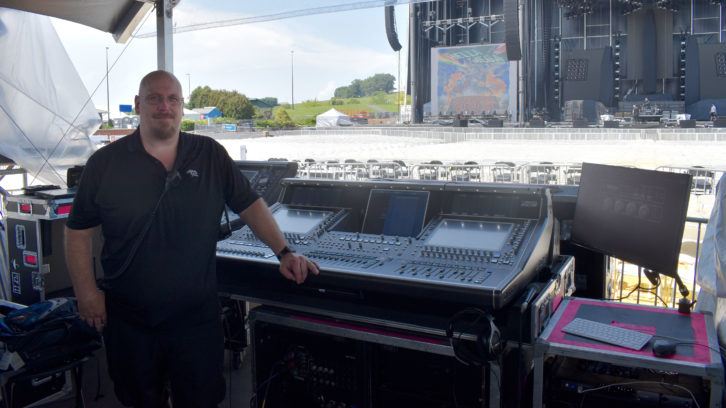
All the tour’s audio pros were glad to be working again, but for Fall Out Boy’s longtime FOH engineer, Chad Olech, it took some getting used to: “I’ll tell you what—when I went to prep everything, I felt like a complete idiot when I stepped up to the console. It’d been 17 months since I went near one, and I spent an hour just trying to remember where buttons were!”
Adding to the urgency, Olech had opted to use the pandemic as a line in the sand, wiping his DiGiCo show file in order start fresh. “I probably did 300 shows on the old show file, and I felt like I was starting to pile stuff on for no reason other than I was bored—I’d put something on to help and then tweak it so much that it needed more help. Now I’m using a lot less stuff than before and it sounds better. I use both Waves and Universal Audio, depending on what the function is.” Also new at the F.O.B. FOH position were a few pieces of analog outboard gear—“I use Warm Audio’s stereo buss compressor on my stereo buss, as well as my drum crush buss. I had the time, figured it was an easy enough thing to try and I’ve really liked the results.”
Olech’s mix was built out of 46 inputs (“It’s four dudes and a couple of playback tracks”), and as Shure endorsees, the band was captured on stage by the brand’s best. Drums were grabbed with Beta 98 AMP/Cs on toms, KSM137s on hi-hat, ride and overhead, Beta 56s on both snares and both a 91 and 52 in the kick. Lead vocals were handled with wireless KSM9s and backing vocals on wired KSM8s, while all guitars were on DIs with singer Patrick Stump additionally using an iso cabinet containing a KSM313 ribbon mic.
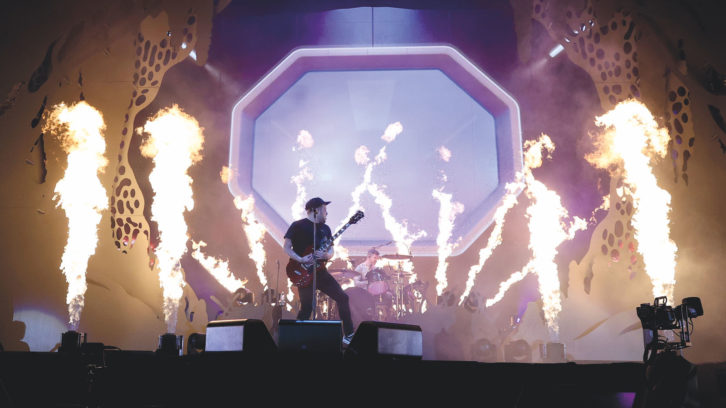
WEEZER KEEPS IT SIMPLE
Over in Weezer’s corner of the FOH tent, Craig Overbay, the band’s engineer since 2000, was also mixing on DiGiCo—in his case, an SD12: “I got a new console two months before the tour because I wanted a smaller footprint, and the SD12 has 96 channels, so that’s more than I could ever need—for doing Weezer, at least.” Still, the split was full at 56 channels, giving Overbay plenty to work with. “I would describe it as, ‘I’m not the producer; I’m the re-producer,’” he joked.
The goal for moving to a new desk was to keep things simple, he explained: “I have no plug-ins; I’m using just what’s in the desk—it has a compressor, gate, multiband compressor on every input and output. I mean, I can dig myself in a hole easy enough without having to look at plug-ins or worrying about the server crashing! I also have some analog outboard gear with us that I like—there’s an API 5500 mastering EQ on the left or right, a Drawmer tube compressor, and then some digital delays and reverbs that I just like. They’re older, they’re grainier, but I don’t think the audience knows or cares as long as they can hear everything and it sounds alright.”
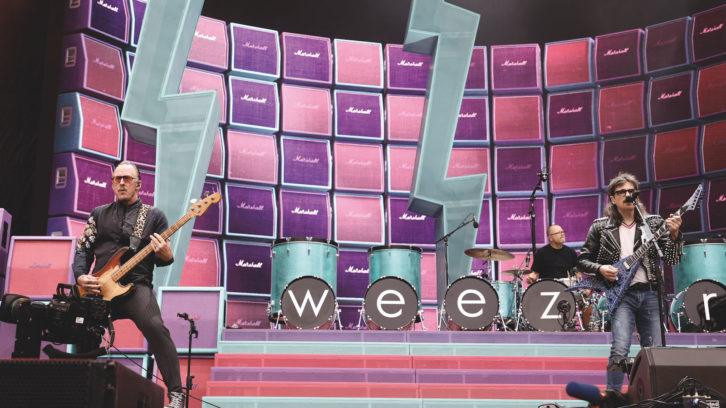
With Hella Mega now completed, the tour has been vindicated as a safe success in a precarious time, providing fans with a much-needed night out—and concert professionals with much-needed work. “I was a little curious how it was gonna go, coming right out of sitting at home for a year and a half,” said Thomas, “but we’ve got a pretty well-dialed machine going on. Our crew has been stellar, and that’s been the fortunate thing about being one of the first large-scale tours out post-pandemic: We got a lot of really good guys, and they’ve been doing a killer job.”
Alexander agreed, adding, “We’ve got an outstanding audio crew with us; they kick ass every day. Everybody’s loving being out here, all the audiences have been amazing, we’re having fun mixing and the bands are playing great. It’s hard to ask for much better, really.”


